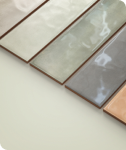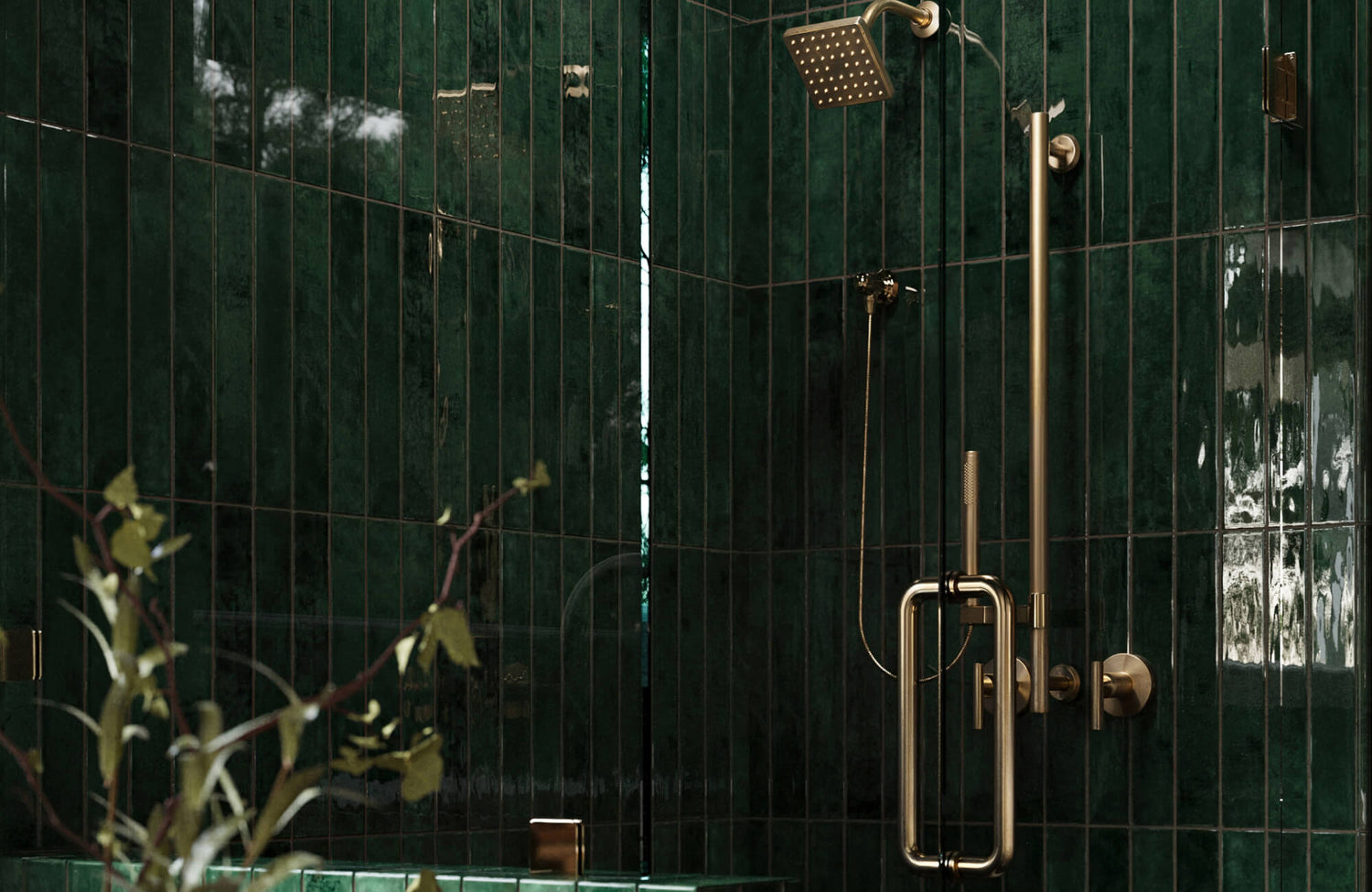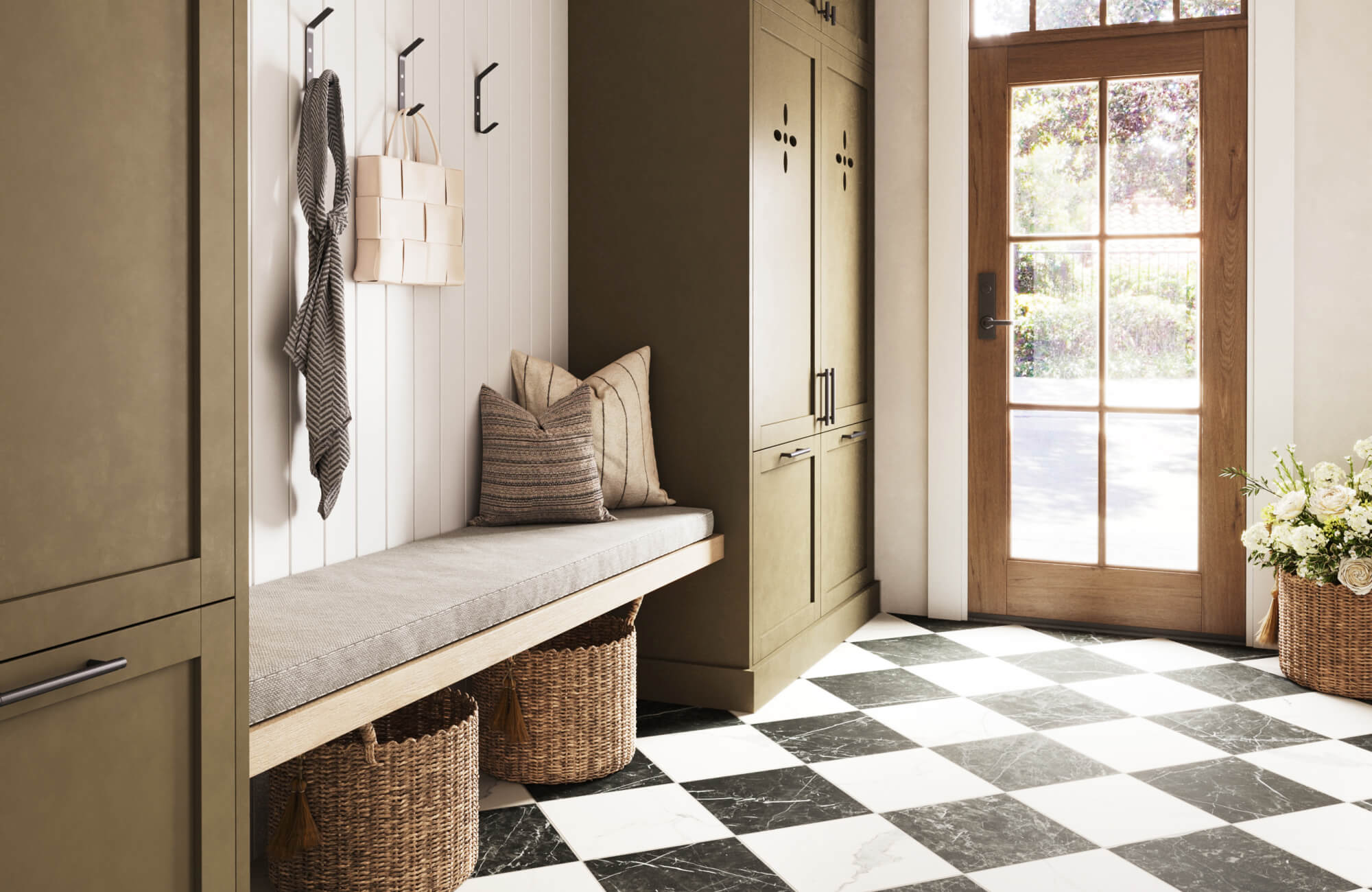The bathroom is a place to unwind and recharge, making color choices essential for creating a relaxing atmosphere. As a key design element, tile color significantly shapes the room’s mood and feel. Soft blues and greens are often considered the most relaxing because of their soothing, nature-inspired qualities. However, warm neutrals or muted tones can also foster a relaxing atmosphere, depending on personal preferences and design style.
This article explores how color psychology, lighting, maintenance, and personal style influence the choice of calming tile colors for your bathroom. Understanding the emotional impact of colors is the first step in crafting a space that feels truly serene.

Color Psychology and Bathroom Design
Color psychology studies how various colors impact emotions and behavior, explaining why certain colors are soothing. In bathrooms, understanding the effects of different hues can help you design a calm and inviting space.
The Power of Cool Colors
Cool tones such as blues, greens, and purples are often associated with tranquility, making them a natural choice for creating a relaxing bathroom environment. These shades, when thoughtfully integrated, can foster a soothing atmosphere ideal for unwinding.
For example, glossy green tiles, like the Lilah 6x6 Glossy Ceramic Tile in Opal, as shown in the photo above, blend sage and emerald tones to evoke a serene, nature-inspired retreat. Their seamless flow from walls to ceiling, complemented by a soft, neutral mosaic floor, enhances the sense of harmony. Natural light filtering through a large window further amplifies the calming effect.
Similarly, pale blue tiles can mirror the serenity of a clear sky or gentle ocean waves, while lavender accents lend a subtle touch of elegance and introspection. When paired with natural materials such as wood or stone, these tones come together to create a balanced, spa-like ambiance that invites relaxation and peace.
The Energy of Warm Colors
Warm tones such as red, orange, and yellow bring energy to a bathroom. Although they are often more vibrant, these colors can still foster relaxation when incorporated thoughtfully and in moderation.
For instance, muted terracotta tiles on the floor, paired with cream walls and wooden fixtures, create a cozy, inviting ambiance. Similarly, a few golden-yellow mosaic tiles scattered within a neutral backdrop can subtly brighten the room without overwhelming it. If bolder options appeal to you, a red tile feature wall can add character, provided it is balanced with softer tones elsewhere to maintain a harmonious and calming atmosphere.
To explore how different tile colors might work in your space, Edward Martin offers an augmented reality (AR) tool that allows you to visualize options directly in your bathroom. This practical feature makes it easier to choose tiles that suit both your style and functional needs.

The Impact of Lighting on Tile Color Perception
The atmosphere of a bathroom is influenced not only by the choice of colors but also by the interplay between light and those colors. This interaction shapes the overall mood, fostering a sense of relaxation and comfort.
Natural light, for example, can enhance tile colors by adding depth and dimension. A bathroom featuring Jaden 2.5x16 Glossy Ceramic Tile in Eggshell (photo above) illustrates how a glossy finish can subtly reflect and amplify light. The vertical layout of these tiles creates clean, modern lines, while their reflective surface captures sunlight streaming through large windows, making the muted off-white tone appear more vibrant. This effect is further enhanced by wood accents and gold fixtures, which together create a balanced and cohesive design that feels inviting and serene.
As daylight fades, artificial lighting takes over, offering its own influence on the room’s ambiance. Warm white lights bring out the cozy undertones of neutral tiles, while cooler white bulbs emphasize the crispness of shades like blue and grey. The glossy finish of the Jaden tile adapts well to both types of lighting, maintaining a polished appearance and ensuring the bathroom remains visually appealing throughout the day.
The Practicality of Tile Color: Maintenance and Durability
While lighting influences the mood of a bathroom, practical considerations like maintenance and durability are equally vital for ensuring long-term functionality. Selecting tile colors that align with your cleaning preferences helps maintain a balance between visual appeal and practicality.
Light-colored tiles, such as white, cream, or light grey, create a bright and open atmosphere, making them popular for smaller bathrooms. For instance, using white ceramic subway tiles on walls and light grey porcelain flooring can enhance a room’s sense of spaciousness. However, these lighter shades tend to show dirt and water stains more prominently, requiring consistent cleaning to retain their fresh appearance. With regular care, such as using mild detergents, their crisp and clean look can be preserved, making them a good choice for those who prioritize a tidy aesthetic.
In contrast, dark-colored tiles, such as black or navy, offer a sense of intimacy and luxury. A shower with deep charcoal tiles, complemented by brushed gold fixtures, can exude sophistication while concealing dirt more effectively—ideal for busy households. That said, these tones may make smaller bathrooms feel more confined, so they are often best suited for larger spaces or as accent features. To maintain their sleek appearance, occasional deep cleaning and careful drying after use is recommended.
Enhancing Relaxation Through Tile Textures, Finishes, and Patterns
While color and maintenance are important considerations, the ambiance of a bathroom is also shaped by the textures, finishes, and patterns of the tiles. These elements contribute to the design while aligning with personal preferences for relaxation.
Textures and Finishes
Matte tiles reduce glare and create a grounded feel, making them suitable for spa-like settings. Glossy tiles, on the other hand, reflect light, increasing brightness and making spaces appear larger, especially in smaller or low-light areas, but too much shine can detract from a calming atmosphere. Textured tiles, such as stone-look or wood-look, add a tactile element and connect the bathroom to natural elements, enhancing relaxation.
Glossy tiles, such as the Mikayla 5x5 Glossy Ceramic Tile in Cerulean, as shown in the photo above, exemplify how finishes can elevate the ambiance of a bathroom. The vibrant cerulean hue adds a bold yet soothing dimension, while the glossy finish reflects light beautifully, amplifying brightness and making the space feel more open. These tiles are particularly effective in smaller bathrooms or those aiming to create a spa-like retreat, where light reflection enhances the sense of tranquility.
When paired with contrasting textures, such as the black-and-white mosaic floor tiles and matte or metallic fixtures, the glossy cerulean tiles bring a perfect balance of boldness and relaxation. This interplay of finishes not only adds depth to the design but also creates a harmonious atmosphere that feels fresh and contemporary while maintaining a calming, restorative vibe.
Shapes and Patterns
Tile shapes and patterns significantly impact the bathroom's visual flow and ambiance. For instance, hexagonal tiles and soft curves create rhythm and continuity, suitable for both walls and floors. Subway tiles, especially in herringbone or stacked layouts, create visual interest while maintaining symmetry. In addition, large format tiles reduce grout lines, creating a seamless, open look. Mosaic tiles, with their intricate organic or geometric designs, add texture and detail without overwhelming the space. Thoughtful combinations of these elements can transform a bathroom into a harmonious and relaxing environment.

Personal Style and Cultural Influences
While textures, finishes, and patterns play a role in bathroom design, the space should ultimately reflect your individuality. By incorporating personal style and drawing from cultural influences, you can create a bathroom that feels personal and harmonious. Additionally, your preferences are often shaped by traditions that align with your sense of relaxation.
Scandinavian Minimalism
If you lean toward a minimalist aesthetic, Scandinavian design might be a fitting source of inspiration. Tiles in light shades such as white, beige, or pale grey, paired with clean lines and natural textures, contribute to a calm and functional bathroom. For instance, beige subway tiles arranged in a stacked pattern alongside a pale wooden vanity reflect the essence of Scandinavian simplicity. To add contrast without disrupting the cohesive design, a black-framed mirror and soft lighting can bring subtle depth while maintaining a serene ambiance.
Mediterranean Charm
For those who appreciate richer hues, Mediterranean-inspired palettes—featuring blues, aquas, and terracotta tones—offer a serene connection to the sea and sunlit landscapes. These colors create a retreat that feels both timeless and inviting. Picture a bathroom with aqua fishscale tiles on the walls, complemented by a patterned terracotta floor and brass fixtures. This combination captures an authentic Mediterranean design. Alternatively, soft blue tiles can be used as a backsplash for a freestanding white tub, resulting in a design that is both refreshing and grounded in tradition.
Japanese Zen Aesthetics
For those seeking mindfulness and balance, Japanese design offers subtle inspiration. The combination of green and brown tiles, often complemented by wood-like or stone-like textures, fosters a natural and calming atmosphere. For instance, pale green tiles in a walk-in shower paired with bamboo shelving can evoke the serenity of a Zen garden, seamlessly blending simplicity and nature. Similarly, using dark brown floor tiles with a stone-like finish, along with minimalist décor, enhances the grounded and tranquil essence that defines Japanese aesthetics.
Tropical Escape
Vibrant greens and aqua tones can evoke a tropical atmosphere, balancing energy and tranquility while connecting the space to nature. These hues are particularly effective in bathrooms emphasizing a seamless indoor and outdoor flow. For instance, vivid green subway tiles paired with an aqua mosaic floor can recreate the lush ambiance of a rainforest. Similarly, incorporating tropical plants near a freestanding bathtub framed by aqua tiles enhances the natural vibe, bridging the gap between the indoors and outdoors.
In the photo above, the Jaden 2.5x16 Glossy Ceramic Tile in Hunter creates a striking yet soothing backdrop with its deep, lustrous green reminiscent of lush forests. This elongated, shade-varying subway tile enhances the space’s texture, while the high-gloss finish adds a sense of depth by catching natural light in soft, undulating reflections. Complemented by the understated luxury of gold fixtures and the subtle presence of greenery, these elements form a harmonious blend of natural inspiration and crafted sophistication, ideal for evoking a tranquil escape.
Ultimately, incorporating cultural and regional design influences allows you to personalize your bathroom and make it truly your own. Whether you gravitate toward minimalist neutrals, Mediterranean-inspired tones, or Zen-like earthy palettes, the most important consideration is choosing elements that resonate with your sense of comfort and relaxation.
Finding Your Perfect Bathroom Sanctuary
The most relaxing tile colors for a bathroom typically include cool tones such as blues and greens, which are known for their calming qualities, as well as soft neutrals like beige, grey, and white that help create a sense of openness. These colors work harmoniously with lighting to enhance their effect. Personal style also adds a touch of individuality, making the space truly your own.
If you’re ready to begin designing your bathroom retreat, Edward Martin offers a curated selection of tiles in various textures and colors. By exploring our samples firsthand, you can confidently find the perfect match that aligns with both your aesthetic preferences and the tranquil atmosphere you wish to create.









